Small molecule inhibitors of mammalian GSK-3β promote in vitro plant cell reprogramming and somatic embryogenesis in crop and forest species
- PMID: 34338766
- PMCID: PMC8664590
- DOI: 10.1093/jxb/erab365
Small molecule inhibitors of mammalian GSK-3β promote in vitro plant cell reprogramming and somatic embryogenesis in crop and forest species
Abstract
Plant in vitro regeneration systems, such as somatic embryogenesis, are essential in breeding; they permit propagation of elite genotypes, production of doubled-haploids, and regeneration of whole plants from gene editing or transformation events. However, in many crop and forest species, somatic embryogenesis is highly inefficient. We report a new strategy to improve in vitro embryogenesis using synthetic small molecule inhibitors of mammalian glycogen synthase kinase 3β (GSK-3β), never used in plants. These inhibitors increased in vitro embryo production in three different systems and species, microspore embryogenesis of Brassica napus and Hordeum vulgare, and somatic embryogenesis of Quercus suber. TDZD-8, a representative compound of the molecules tested, inhibited GSK-3 activity in microspore cultures, and increased expression of embryogenesis genes FUS3, LEC2, and AGL15. Plant GSK-3 kinase BIN2 is a master regulator of brassinosteroid (BR) signalling. During microspore embryogenesis, BR biosynthesis and signalling genes CPD, GSK-3-BIN2, BES1, and BZR1 were up-regulated and the BAS1 catabolic gene was repressed, indicating activation of the BR pathway. TDZD-8 increased expression of BR signalling elements, mimicking BR effects. The findings support that the small molecule inhibitors promoted somatic embryogenesis by activating the BR pathway, opening up the way for new strategies using GSK-3β inhibitors that could be extended to other species.
Keywords: Barley; brassinosteroids; cell reprogramming; cork oak; glycogen synthase kinase; microspore embryogenesis; rapeseed; small molecule inhibitors; somatic embryogenesis.
© The Author(s) 2021. Published by Oxford University Press on behalf of the Society for Experimental Biology.
Figures


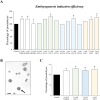
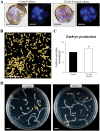
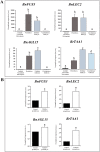

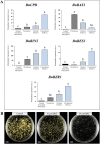
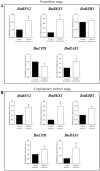


Comment in
-
Small molecules mediate cellular reprogramming across two kingdoms.J Exp Bot. 2021 Dec 4;72(22):7645-7647. doi: 10.1093/jxb/erab493. J Exp Bot. 2021. PMID: 34865113
Similar articles
-
Small molecule inhibitors of human LRRK2 enhance in vitro embryogenesis and microcallus formation for plant regeneration of crop and model species.J Plant Physiol. 2024 Dec;303:154334. doi: 10.1016/j.jplph.2024.154334. Epub 2024 Aug 23. J Plant Physiol. 2024. PMID: 39288631
-
The mood stabilizing properties of AF3581, a novel potent GSK-3β inhibitor.Biomed Pharmacother. 2020 Aug;128:110249. doi: 10.1016/j.biopha.2020.110249. Epub 2020 May 26. Biomed Pharmacother. 2020. PMID: 32470749
-
Somatic Embryogenesis of Quercus suber L. From Immature Zygotic Embryos.Methods Mol Biol. 2018;1815:247-256. doi: 10.1007/978-1-4939-8594-4_16. Methods Mol Biol. 2018. PMID: 29981126
-
Microspore embryogenesis: targeting the determinant factors of stress-induced cell reprogramming for crop improvement.J Exp Bot. 2019 Jun 1;70(11):2965-2978. doi: 10.1093/jxb/ery464. J Exp Bot. 2019. PMID: 30753698 Review.
-
Drug development targeting the glycogen synthase kinase-3beta (GSK-3beta)-mediated signal transduction pathway: role of GSK-3beta in adult brain.J Pharmacol Sci. 2009 Feb;109(2):174-8. doi: 10.1254/jphs.08r29fm. Epub 2009 Jan 29. J Pharmacol Sci. 2009. PMID: 19179803 Review.
Cited by
-
Glycogen synthase kinases in model and crop plants - From negative regulators of brassinosteroid signaling to multifaceted hubs of various signaling pathways and modulators of plant reproduction and yield.Front Plant Sci. 2022 Jul 15;13:939487. doi: 10.3389/fpls.2022.939487. eCollection 2022. Front Plant Sci. 2022. PMID: 35909730 Free PMC article. Review.
-
Small molecules, enormous functions: potential approach for overcoming bottlenecks in embryogenic tissue induction and maintenance in conifers.Hortic Res. 2024 Jul 10;11(8):uhae180. doi: 10.1093/hr/uhae180. eCollection 2024 Aug. Hortic Res. 2024. PMID: 39108576 Free PMC article. Review.
References
-
- Baki A, Bielik A, Molnár L, Szendrei G, Keserü GM. 2007. A high throughput luminescent assay for glycogen synthase kinase-3beta inhibitors. Assay and Drug Development Technologies 5, 75–83. - PubMed
Publication types
MeSH terms
Substances
LinkOut - more resources
Full Text Sources
Other Literature Sources

